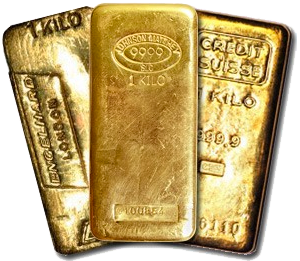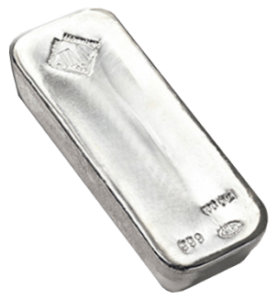Modern Bullion Coins
A bullion coin is a coin struck from precious metal and kept as a store of value or an investment, rather than used in day-to-day commerce. Investment coins are generally coins that have been minted after 1800, have a purity of not less than 900 thousandths and are or have been a legal tender in their country of origin.
Bullion coins are usually available in gold and silver, with the exception of the Krugerrand and the Swiss Vreneli which are only available in gold. The American Eagle series is available in gold, silver and platinum, and the Canadian Maple Leaf series is available in gold, silver, platinum and also palladium.
Bullion coins are also typically available in various weights. These are usually multiples or fractions of 1 troy ounce, but some bullion coins are produced in very limited quantities in kilograms and even heavier.
Links To Our Inventory of Bullion Products
Bullion coins sell for a premium over the market price of the metal on the commodities exchanges. This is due to their comparative small size and the costs associated with manufacture, storage and distribution. The margin that is paid varies depending on what type of coin it is, the weight of the coin, and the precious metal.
Bullion Bars and Ingots
 A gold bar is a quantity of refined metallic gold of any shape that is made by a bar producer meeting standard conditions of manufacture, labeling, and record keeping.
A gold bar is a quantity of refined metallic gold of any shape that is made by a bar producer meeting standard conditions of manufacture, labeling, and record keeping.
Larger gold bars that are produced by pouring the molten metal into molds are called ingots. Smaller bars may be manufactured by minting or stamping from appropriately rolled gold sheets.
The standard gold bar held as gold reserves by central banks and traded among bullion dealer is the 400-troy-ounce (12.4 kg or 438.9 ounces) Good Delivery gold bar.
The kilobar, which is to say 1000 grams in mass, is the bar that is more manageable and is used extensively for trading and investment. The premium on these bars when traded is very low over the spot value of the gold making it ideal for small transfers between banks and traders. Most kilobars are flat, although some investors, particularly in Europe, prefer the brick shape.[1]
A traditional way of investing in silver is by buying actual bullion bars. In some countries, like Switzerland and Liechtenstein, bullion bars can be bought or sold over the counter at major banks.
 The flat, rectangular shape of silver bars makes them ideal for storage in a home safe, a safe deposit box at a bank, or placed in allocated (also known as non-fungible) or unallocated (fungible or pooled) storage with a bank or dealer. Silver is traded in the spot market with the code “XAG”. When settled in United States Dollars, the code is “XAGUSD”.
The flat, rectangular shape of silver bars makes them ideal for storage in a home safe, a safe deposit box at a bank, or placed in allocated (also known as non-fungible) or unallocated (fungible or pooled) storage with a bank or dealer. Silver is traded in the spot market with the code “XAG”. When settled in United States Dollars, the code is “XAGUSD”.
 Various sizes of silver bars:
Various sizes of silver bars:
- 1000 oz troy bars – These bars weigh about 68 pounds avoirdupois (31 kg) and vary about 10% as to weight, as bars range from 900 ozt to about 1,100 ozt (28 to 34 kg). These are COMEX and LBMA good delivery bars.
- 100 oz troy bars – These bars weigh 6.8 pounds (3.11 kg) and are among the most popular with retail investors. Popular brands are Engelhard and Johnson Matthey. Those brands cost a bit more, usually about 40 cents to 2.00 dollars per troy ounce above the spot price, but that price may vary with market conditions.
- Odd weight retail bars – These bars cost less and generally have a wider spread, due to the extra work it takes to calculate their value and the extra risk due to the lack of a good brand name.
- 1 kilogram bars (32.15 oz troy)
- 10 oz troy bars and 1 oz troy bars (311 and 31.1 g)

